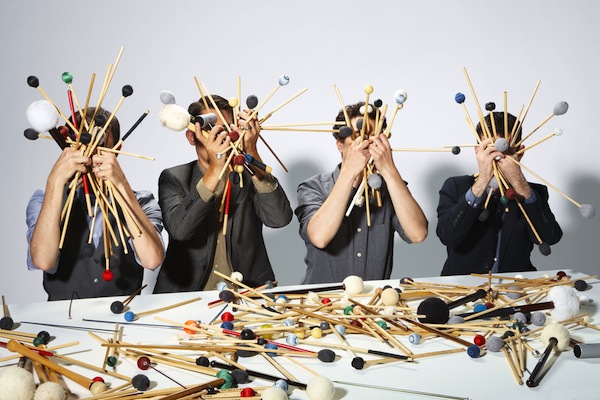Cerrone’s ambient-pop aesthetic makes a distinctive impression with Third Coast Percussion

Third Coast Percussion performed music of Christopher Cerrone at the MIller Theater’s Composer Portrait series Thursday night.
No single artist can represent their entire generation. But Miller Theatre’s Composer Portrait of Christopher Cerrone did a substantial job Thursday night of representing the musical thinking that is a central part of so many young composers.
That thinking comes out of pop music. That in itself is nothing new in a century that has seen the waxing and waning of the indie- or alt-classical style. In the intermission conversation between Cerrone and David Skidmore, a member of Third Coast Percussion, the composer talked about growing up with the idea that the tools of the pop trade—electric guitars, drums, microphones—were as natural to use as a composer.
What makes Cerrone’s voice distinctive, as heard in his three pieces played by Third Coast, is the specific flavor of pop that comes through. He’s not a rocker, he’s a dreamer, making textures and images that come out of ambient music.
Writing for percussion has been Cerrone’s focus so far. The evening opened with the world premiere of A Natural History of Vacant Lots, a co-commission between Miller and Third Coast. That piece set much of the tone for the night; consonant, resonant, gorgeous, with a comforting physical effect.
A Natural History and Memory Palace, which followed it in the first half, were played by the ensemble over a bed of prerecorded audio; ringing, metallic percussion for the former, and the singing of summertime cicadas during the latter. Those sounds were expertly mixed by Steve Cooper, whose sound design accomplished the seemingly impossible task of turning Miller into a resonant space.
And as Cerrone pointed out, his music lives inside that space. Part of this is that he uses simple, spare harmonies, short melodic lines and architectural juxtapositions of major and minor chords. His consonance needs room to reverberate and settle.
The live resonance carried his music into every nook and cranny of the theater. That is an important feature of the ambient aesthetic, musical sound that becomes a palpable mass, like an interior being filled with a fluid, three-dimensional Rothko image.
A Natural History and Memory Palace touched just that, and they also had the deeply pleasurable quality of music without any particular teleology. Both came from specific extra-musical ideas, from a book about the flora and fauna that fills vacant lots, and the construction of a personal memory palace, respectively. They were in no way narrative, though, and the listener could ascribe to them whatever meaning felt right, or no meaning at all.
There was purpose to every musical moment, but no defining goal. The interior motion was stately, or in Memory Palace often agitated. The writing used almost entirely pitched instruments—vibraphones, marimbas, temple blocks—so the percussionists were playing melodies. They also played Cerrone’s sharp, clear rhythms with great musicality.
Both pieces rippled out in waves, a constant, evenly delineated motion defined by the enclosure of space and time. A Natural History had an undulating sweep to it that was gently mesmerizing, while Memory Palace(which can be heard on a fine 2017 CD by the Los Angeles Percussion Quartet on the Sono Luminus label) explored a range of acutely mixed feelings before signing off with a pithy melody. That theme was played by two of the musicians blowing across the tops of various empty bottles—one of the loveliest moments heard in concerts this season.
That quality carried through the closing work, Goldbeater’s Skin, text-based music that featured the excellent mezzo-soprano Rachel Calloway. The dry bite of her timbre and her cultured articulation were at first a little startling to hear against Cerrone’s palette of pastels and primary colors.
Cerrone’s writing for the voice in this piece was like that for percussion—motion between notes was primarily intervallic with an emphasis on rhythm. Not classic melodic writing, much more in line with a background of listening to pop music, and highly effective.
With poetry by G.C. Waldrop that was full of nature imagery, the percussionists kept the music flowing underneath Calloway, then responded with intensity in brief interludes that focussed on the basic type of instrument, wood, metal, or skin.
In the last interlude, and through the final movement, “Against the Madness of Crowds,” the music brought the voice and instruments together to produce a powerful effect. Harder-edged than the first half, the weight in Goldbeater’s Skin and the exciting playing still created the same evocative, substantial beauty.
The season’s Composer Portraits series concludes 8 p.m. April 19 with music of Fred Rzewski. millertheatre.org